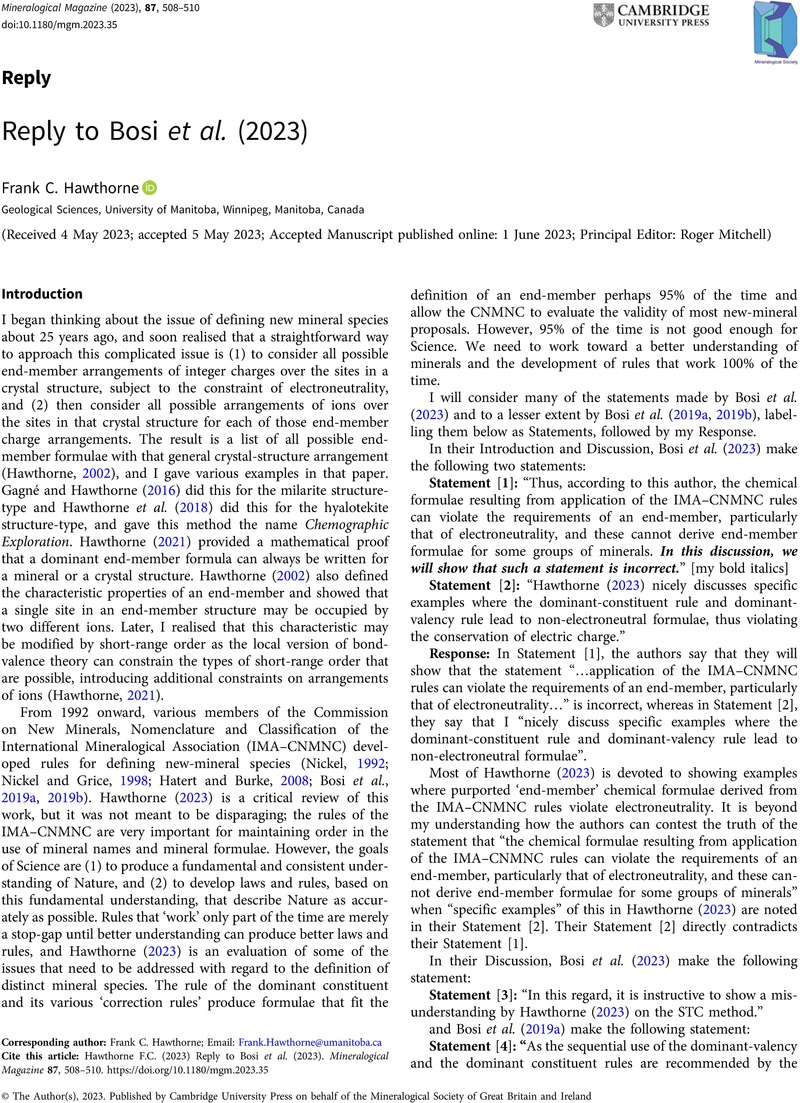No CrossRef data available.
Article contents
Reply to Bosi et al. (2023)
Published online by Cambridge University Press: 01 June 2023
Abstract
An abstract is not available for this content so a preview has been provided. Please use the Get access link above for information on how to access this content.

- Type
- Reply
- Information
- Copyright
- Copyright © The Author(s), 2023. Published by Cambridge University Press on behalf of the Mineralogical Society of Great Britain and Ireland
Footnotes
Principal Editor: Roger Mitchell
References
Bosi, F. (2018) On the mineral nomenclatures: the dominant-valency rule. Abstract to XXII meeting of the IMA, Melbourne, Australia, 2018, 354.Google Scholar
Bosi, F., Hatert, F, Hålenius, U., Pasero, M., Miyawaki, R. and Mills, S.J. (2019a) On the application of the IMA−CNMNC dominant-valency rule to complex mineral compositions. Mineralogical Magazine, 83, 627–632.Google Scholar
Bosi, F., Biagioni, C. and Oberti, R. (2019b) On the chemical identification and classification of minerals. Minerals, 9, 591–603.Google Scholar
Bosi, F., Hatert, F., Pasero, M., Mills, S.J., Miyawaki, R. and Halenius, U. (2023) A brief comment on Hawthorne (2023): “On the definition of distinct mineral species: A critique of current IMA-CNMNC procedures”. Mineralogical Magazine, 87, doi:10.1180/mgm.2023.33Google Scholar
Gagné, O. and Hawthorne, F.C. (2016) Chemographic exploration of the milarite-type structure. The Canadian Mineralogist, 54, 1229–1247.Google Scholar
Hatert, F. and Burke, E.A.J. (2008) The IMA–CNMNC dominant-constituent rule revisited and extended. The Canadian Mineralogist, 46, 717–728.Google Scholar
Hawthorne, F.C. (2002) The use of end-member charge-arrangements in defining new mineral species and heterovalent substitutions in complex minerals. The Canadian Mineralogist, 40, 699–710.Google Scholar
Hawthorne, F.C. (2021) Proof that a dominant endmember formula can always be written for a mineral or a crystal structure. The Canadian Mineralogist, 59, 159–167.Google Scholar
Hawthorne, F.C. (2023) On the definition of distinct mineral species: A critique of current IMA-CNMNC procedures. Mineralogical Magazine, 87, doi:10.1180/mgm.2023.8Google Scholar
Hawthorne, F.C., Sokolova, E., Agakhanov, A.A., Pautov, L.A., Karpenko, V.Yu. and Grew, E.S. (2018) Chemographic exploration of the hyalotekite structure-type. Mineralogical Magazine, 82, 929–937.Google Scholar
Hawthorne, F.C., Mills, S.J., Hatert, F. and Rumsey, M.S. (2021) Ontology, archetypes and the definition of “mineral species”. Mineralogical Magazine, 85, 125–131; erratum, 85, 830.Google Scholar
Nickel, E.H. (1992) Solid solutions in mineral nomenclature. The Canadian Mineralogist, 30, 231–234.Google Scholar
Nickel, E.H. and Grice, J.D. (1998) The IMA commission on new minerals and mineral names: procedures and guidelines on mineral nomenclature. The Canadian Mineralogist, 36, 913–926.Google Scholar




